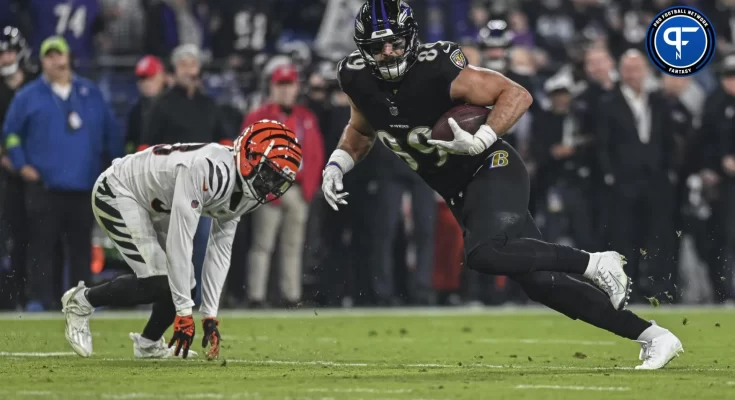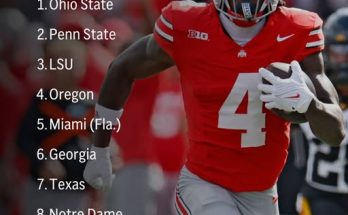Ravens Training Camp Unveils New Offensive Era: Andrews Shows Wear While Mitchell Electrifies
The Baltimore Ravens’ 2025 training camp has become a fascinating study in NFL evolution, where the gradual decline of a franchise icon intersects with the explosive arrival of a new offensive weapon. Tight end Mark Andrews, once Lamar Jackson’s most trusted target, is visibly struggling to separate from defenders during practices, while second-year running back Keaton Mitchell has coaches scrambling to design new plays to exploit his game-breaking speed. These dueling narratives dominated the team’s first week in Owings Mills, offering glimpses of both the difficult transitions and exciting possibilities ahead for an offense aiming to reclaim its spot among the league’s elite.
Andrews’ situation carries particular weight given his legendary status in Baltimore. The three-time Pro Bowler, now 30, looks noticeably slower coming out of breaks during one-on-one drills, with several defensive backs—including rookie corner Nate Wiggins—consistently blanketing him in coverage. Where Andrews once dominated the intermediate middle of the field with crisp routes and vice-grip hands, he’s now fighting through more dropped passes and failed contested catches than at any point in his seven-year career. Team sources indicate his recovery from 2023’s brutal ankle injury (which required two surgeries) robbed him of the quick-twitch explosiveness that made him uncoverable in his prime. “Father Time is kicking my ass right now,” Andrews joked with reporters after a particularly grueling red-zone session where he failed to haul in three straight Jackson passes. The humor couldn’t mask the sobering reality: Baltimore’s offensive identity must evolve beyond the Andrews safety valve that once defined it.
Enter Keaton Mitchell, the undrafted revelation who’s turning every practice into his personal highlight reel. The 23-year-old speedster has added 12 pounds of muscle since his rookie season without losing the 4.37 wheels that produced 9.1 yards per carry in limited 2024 action. During Tuesday’s full-team scrimmage, Mitchell left All-Pro linebacker Roquan Smith grasping at air on a wheel route touchdown, then later ripped off a 70-yard scoring run where he outran every defender by the 30-yard line. His acceleration through holes is so sudden that offensive coordinator Todd Monken has installed new jet sweep and screen packages specifically to weaponize it. “That boy’s got rockets in his cleats,” gushed fullback Patrick Ricard after watching Mitchell torch the second-team defense for three long touchdowns in one practice. While Derrick Henry remains the nominal starter, Mitchell’s workload is expanding daily as coaches realize his potential to become Baltimore’s most dangerous home-run hitter since peak Marquise Brown.
The changing offensive hierarchy presents both challenges and opportunities for Jackson. The quarterback’s chemistry with Andrews borders on telepathic—their 46 career touchdowns rank second among active QB-TE duos—but he’s wisely begun developing new connections. Rookie tight end Devin Culp, a fourth-round pick from Washington, has become Jackson’s favorite red-zone target early in camp, using his 6’4″ frame to box out defenders on back-shoulder fades. First-round receiver Xavier Worthy’s blistering speed has opened deep passing lanes that simply didn’t exist in previous seasons. Yet Jackson still forces occasional throws to Andrews out of loyalty, a habit coaches are gently trying to break. “Lamar’s gonna Lamar,” said passing game specialist Keith Williams. “But he’s learning he’s got some shiny new toys to play with too.”
Mitchell’s emergence couldn’t come at a better time for a run game in transition. Henry, while still effective in short-yardage situations, has noticeably lost a step at 31 years old. His 3.8 yards-per-carry average in team drills reflects the reality that Baltimore can no longer rely on him as a bell-cow back. Mitchell’s skill set perfectly complements this new reality—his ability to turn check-downs into explosive gains adds a dimension the Ravens haven’t possessed since the Ray Rice era. During Thursday’s situational drills, Mitchell scored from 20+ yards out on three separate screen passes, each time making the first defender miss in space. His improved pass protection (a weakness last season) has convinced coaches to keep him on the field for third downs, a role previously reserved for Justice Hill.
Andrews isn’t going quietly into that good night, however. Teammates rave about his leadership in tight end meetings, where he’s taken Culp and Isaiah Likely under his wing. His blocking remains elite—a fact highlighted when he stonewalled Pro Bowl edge rusher Odafe Oweh during Friday’s goal-line period. There’s still value in a savvy veteran who knows every coverage nuance and can mentor younger players, even if his days of 1,000-yard seasons are likely over. The Ravens may ultimately phase him into more of a specialized role (red-zone packages, two-TE sets) rather than the every-down monster he once was.
Financial realities loom over this transition. Andrews carries a $16.9 million cap hit in 2025—third-highest on the team—with no guaranteed money remaining. His contract becomes a logical restructure candidate if his practice struggles translate to preseason games. Mitchell, by contrast, represents incredible value on his $985,000 salary, the type of cost-controlled production that allows contenders to spend elsewhere. General manager Eric DeCosta faces difficult decisions about how to allocate resources for an offense that’s clearly shifting toward speed and youth after years of heavy personnel.
On the defensive side, players are buzzing about the challenges Mitchell presents daily. Safety Kyle Hamilton called him “the toughest cover in our backfield” after getting roasted on an angle route during seven-on-sevens. Even All-Pro cornerback Marlon Humphrey admitted, “You can’t blink against 34 [Mitchell], or he’s gone.” This respect from elite defenders suggests Mitchell’s camp performance isn’t just beating up on backups—he’s legitimately stressing one of the NFL’s best defenses.
The Ravens’ preseason opener against Philadelphia on August 9 will provide the first real glimpse of how these trends translate to game action. Andrews will likely see limited snaps as coaches protect his body, while Mitchell figures to get extended run with both the first and second units. How Jackson distributes targets between his old security blanket and new playmakers could foreshadow Baltimore’s regular-season offensive hierarchy.
What’s unfolding in Owings Mills is the natural lifecycle of an NFL contender—beloved veterans giving way to explosive youth, offensive identities evolving to maximize changing skill sets. Andrews’ decline, while bittersweet, was inevitable for a tight end with his physical style of play. Mitchell’s rise offers thrilling possibilities for an offense that’s been craving game-breaking speed. Together, their stories remind us that football waits for no one, not even franchise icons. The Ravens aren’t rebuilding in 2025; they’re reloading with a new generation of weapons designed to maximize Lamar Jackson’s prime. And if training camp is any indication, the results might just be electric.
As the midday sun bakes the practice fields this week, you’ll find Andrews staying late to work with Jackson on timing routes, while Mitchell dazzles teammates with another impossible cut. Two players at opposite career arcs, each writing the next chapter of Ravens football in their own way. The torch isn’t being passed yet—but its glow is unmistakably shifting toward the future.



